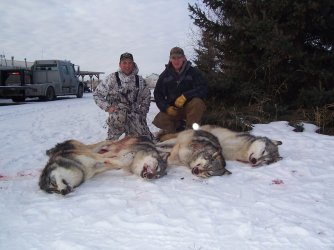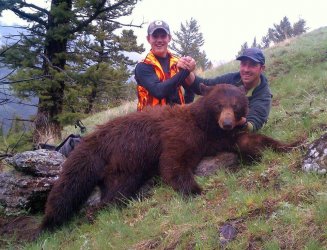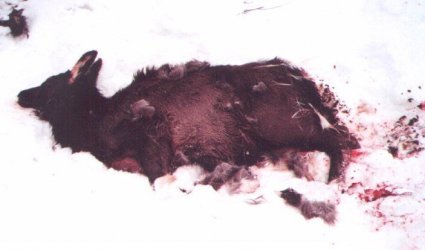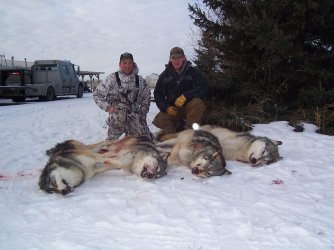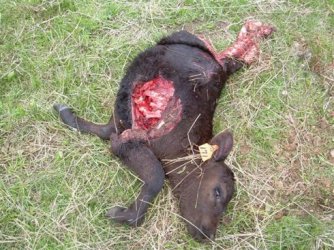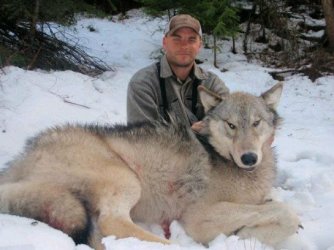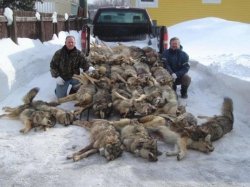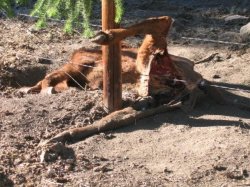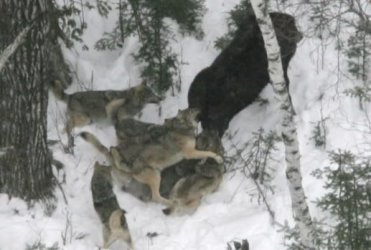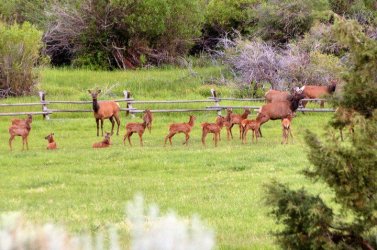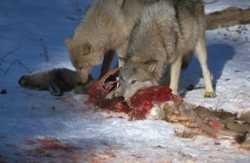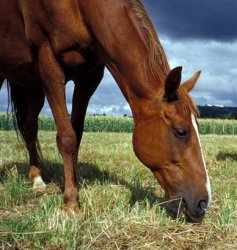Navigation
Install the app
How to install the app on iOS
Follow along with the video below to see how to install our site as a web app on your home screen.

Note: This feature currently requires accessing the site using the built-in Safari browser.
More options
You are using an out of date browser. It may not display this or other websites correctly.
You should upgrade or use an alternative browser.
You should upgrade or use an alternative browser.
Graphic Photos Sorry!!
- Thread starter FRIKSHUN
- Start date
The Infidel
EVIL CONSERVATIVE
I see it as wolves being wolves... dont like them, dont live amoungst them 
I hate seeing the beautiful creatures being killed for doing what nature would have them do... being a predator.
Those pics suck... just my opinion though.

I hate seeing the beautiful creatures being killed for doing what nature would have them do... being a predator.
Those pics suck... just my opinion though.
- Thread starter
- #3
“Wolves and wolf management have nothing to do with wolves,” says Ed Bangs, Northern Rockies Wolf Recovery Coordinator for the US Fish and Wildlife Service. “I think the folks who didn’t like them still don’t like them, and the folks who did like them still do. Wolves are mainly a symbolic issue that relates to core human values … I think the only reason wolf reintroduction finally happened was that people with different values moved to Montana and diluted the strong agricultural influence. Plus, the economy changed from straight agriculture and natural resource consumption to areas such as tourism. …I think in time the debate will get less shrill because living with ‘real’ wolves does moderate the strong and highly polarized, all-bad or all-good opinions.”
Bringing Back the Pack
Gray wolf populations were extirpated from the western U.S. by the 1930s, at the hands of the government agents, people who shot wolves to earn the government-paid bounty, and ranchers attempting to protect livestock—some of whose descendants continue to ranch the same lands today. In later decades, wolves from Canada occasionally walked south into Montana and Idaho, but they failed to survive long enough to reproduce.
The rise of environmentalism and specifically the passage of the Endangered Species Act (ESA) in 1973 created a new atmosphere for wolf advocacy. Organizations including Defenders of Wildlife and the National Wildlife Federation spearheaded a successful effort to have wolves listed as “endangered” under the ESA’s provisions. Not only were bounty programs discontinued, but also it became illegal to kill wolves. In addition, the federal government became obligated to implement a plan for the recovery of the wolf population.
edited
Bringing Back the Pack
Gray wolf populations were extirpated from the western U.S. by the 1930s, at the hands of the government agents, people who shot wolves to earn the government-paid bounty, and ranchers attempting to protect livestock—some of whose descendants continue to ranch the same lands today. In later decades, wolves from Canada occasionally walked south into Montana and Idaho, but they failed to survive long enough to reproduce.
The rise of environmentalism and specifically the passage of the Endangered Species Act (ESA) in 1973 created a new atmosphere for wolf advocacy. Organizations including Defenders of Wildlife and the National Wildlife Federation spearheaded a successful effort to have wolves listed as “endangered” under the ESA’s provisions. Not only were bounty programs discontinued, but also it became illegal to kill wolves. In addition, the federal government became obligated to implement a plan for the recovery of the wolf population.
edited
Last edited by a moderator:
- Banned
- #4
Sorry for posting this but these wolves are out there and doing so much damage to the farmers/ranchers!
Just wondering about your pics.
The first one looks like a wolf shoot.... nothing there with wolves damaging the farmers ranchers.
The second one is a bear shoot..... nothing there with wolves damaging the farmers ranchers.
I am not sure what animal the pic is... but it sure doesn't look like live stock to me.... so again.. nothing there with the wolves damaging the farmers or ranchers.
- Thread starter
- #6
Youre probably one that of those type of folks that thinks your beef is being grown in the back of the store next to the chickens laying eggs, next to the cow thats being milked, next to the pig thats being cut up to bring a pork chop to your dinner table.
- Banned
- #8
Youre probably one that of those type of folks that thinks your beef is being grown in the back of the store next to the chickens laying eggs, next to the cow thats being milked, next to the pig thats being cut up to bring a pork chop to your dinner table.
Are you speaking to me or infidel?
As or me...... I am under no allusions as to were my food comes from...or how it gets to my table.
I don't think food is produced in nice plastic trays all covered in plastic wrap. Food... livestock's... is a bloody business.... and predators have been part of that bloody business since the first domesticated livestock was kept.
- Banned
- #9
Ok, I can delete this if I need to, sorry. Just speaking the truth to Infidel.
Its a copy right thing...and part of the TOS. No need to be sorry.....
- Thread starter
- #10
- Banned
- #11
It's out of control!! They are a BEAUTIFUL animal, but the destruction ought to weighs the destruction they are causing here and its getting worse.
Alright... better pics to go with what you are trying to say.....
- Thread starter
- #13
Wolves kill 120 sheep at ranch near Dillon,
HELENA - While the debate about how many wolves are enough to ensure a healthy population will again come to a head in a federal courtroom Monday, a Dillon-area ranch is picking up the pieces from the largest known wolf depredation in recent history.
In a highly unusual move for wolves, they killed about 120 adult male sheep in one incident on the Rebish/Konen Livestock Ranch south of Dillon last week.
That compares with a total of 111 sheep killed by wolves in Montana in 2008, according to Carolyn Sime, the statewide wolf coordinator for Montana Fish, Wildlife and Parks.
"This is one of the most significant losses that I've seen," Sime said. "That situation is really unfortunate."
Suzanne Stone with Defenders of Wildlife added that in the 20 years she's been working toward ensuring healthy wolf populations, this is the first time she's heard of such a mass killing.
"I've heard of bears or mountain lions doing that, but what usually happens is the sheep panic and jump on top of one another or fall into a ditch and suffocate," Stone said. "I've never heard of any situation where wolves killed so much livestock in such a short period of time.
"... This is the most extreme case I've ever heard about."
The ranch has suffered confirmed wolf depredations twice in three weeks. In late July, three wolves - two blacks and a gray - killed at least 26 rams. The gray wolf was lethally shot by a federal wildlife manager, and one of the blacks was injured. They thought that would scare off the rest of the pack.
Last week, wolves struck again. This time, they took out 120 purebred Rambouillet bucks that ranged in size from about 150 to 200 pounds, and were the result of more than 80 years of breeding.
"We went up to the pasture on Thursday (Aug. 20) - we go up there every two or three days - and everything was fine," rancher Jon Konen said. "The bucks were in the pasture; I had about 100 heifers with them on 600 acres."
He had some business to attend to in Billings, so Konen told his son to be sure to check on the livestock while he was gone.
"He called me, and said it was a mess up there. He said there were dead bucks all up and down the creek. We went up there the next day and tried to count them, but there were too many to count," Konen recalled.
"I had tears in my eyes, not only for myself but for what my stock had to go through," he added. "They were running, getting chewed on, bit and piled into a corner. They were bit on the neck, on the back, on the back of the hind leg.
"They'd cripple them, then rip their sides open."
Montana Fish, Wildlife and Parks has taken the lead in wolf management from the U.S. Department of the Interior's Fish and Wildlife Service, and the state agency has a "memorandum of understanding" with the federal Department of Agriculture's Wildlife Services to provide damage management services when livestock are killed by wolves.
After the dead sheep were found, Graeme McDougal with Wildlife Services flew in a small plane over the sheep pasture, looking for the one or two remaining black wolves to complete the control work requested by Montana FWP. Within a half-mile of the sheep pasture, he spotted the Centennial pack of three adult gray wolves and five pups.
McDougal shot and killed the one uncollared adult wolf, but wasn't authorized to remove any more wolves.
This was the first known depredation incident for the Centennial pack in 2009.
Konen doesn't want to wade into the debate over the reintroduction of wolves in the Rockies, but said that in his opinion, it's time to stop managing wolves and start controlling them.
"My bucks were on private ground, in a pasture where we've been pasturing them for 50 years. The wolves were intruders that were in the wrong place," he said.
Wolves were recently taken off the list of animals protected under the Endangered Species Act, and both Montana and Idaho have instituted hunting seasons for them this year. Idaho will allow 265 wolves to be taken by hunters, in a season that starts Tuesday. Montana will allow 75 wolves to be taken, with the season starting Sept. 15.
Montana is home to an estimated 500 wolves, while Idaho has at least 850. Wyoming also has wolves, but they remain under Endangered Species Act protection.
In Stone's opinion, hunting wolves could create even more problems for ranchers.
"If the adults are shot, then the young ones are dispersed too early," Stone said. "Young pups on their own might turn to livestock to survive, and that's not a good situation for anybody."
Her organization has put out a book to educate ranchers on proactive steps they can take to prevent livestock loss, like hiring range riders, hanging "fladry" - closely spaced cloth - on fences, and minimizing attractants such as dead carcasses.
Defenders of Wildlife has spent more than $895,000 since 1998 to help pay for installation of nonlethal methods to prevent conflicts.
Since 1987, they've also made 885 payments totaling $1.35 million to ranchers to compensate for livestock killed by wolves.
In Montana, the Legislature has earmarked $150,000 to compensate ranchers for livestock lost to wolves, and U.S. Sen. Jon Tester, D-Mont., co-sponsored a bill that includes $5 million in federal funding over five years for depredation losses.
George Edwards, state livestock loss mitigation coordinator, said the Rebish/Konen Ranch probably will receive $350 per dead sheep.
But he added that the loss is more than just monetary to ranchers.
"The compensation still doesn't make up for the loss by any means," Edwards said. "The rancher still needs to make up his breeding stock, and people in town may not realize the attachment livestock folk get to their animals. The emotional toll it takes is just indescribable."
Reporter Eve Byron can be reached at (406) 447-4076 or at [email protected]
HELENA - While the debate about how many wolves are enough to ensure a healthy population will again come to a head in a federal courtroom Monday, a Dillon-area ranch is picking up the pieces from the largest known wolf depredation in recent history.
In a highly unusual move for wolves, they killed about 120 adult male sheep in one incident on the Rebish/Konen Livestock Ranch south of Dillon last week.
That compares with a total of 111 sheep killed by wolves in Montana in 2008, according to Carolyn Sime, the statewide wolf coordinator for Montana Fish, Wildlife and Parks.
"This is one of the most significant losses that I've seen," Sime said. "That situation is really unfortunate."
Suzanne Stone with Defenders of Wildlife added that in the 20 years she's been working toward ensuring healthy wolf populations, this is the first time she's heard of such a mass killing.
"I've heard of bears or mountain lions doing that, but what usually happens is the sheep panic and jump on top of one another or fall into a ditch and suffocate," Stone said. "I've never heard of any situation where wolves killed so much livestock in such a short period of time.
"... This is the most extreme case I've ever heard about."
The ranch has suffered confirmed wolf depredations twice in three weeks. In late July, three wolves - two blacks and a gray - killed at least 26 rams. The gray wolf was lethally shot by a federal wildlife manager, and one of the blacks was injured. They thought that would scare off the rest of the pack.
Last week, wolves struck again. This time, they took out 120 purebred Rambouillet bucks that ranged in size from about 150 to 200 pounds, and were the result of more than 80 years of breeding.
"We went up to the pasture on Thursday (Aug. 20) - we go up there every two or three days - and everything was fine," rancher Jon Konen said. "The bucks were in the pasture; I had about 100 heifers with them on 600 acres."
He had some business to attend to in Billings, so Konen told his son to be sure to check on the livestock while he was gone.
"He called me, and said it was a mess up there. He said there were dead bucks all up and down the creek. We went up there the next day and tried to count them, but there were too many to count," Konen recalled.
"I had tears in my eyes, not only for myself but for what my stock had to go through," he added. "They were running, getting chewed on, bit and piled into a corner. They were bit on the neck, on the back, on the back of the hind leg.
"They'd cripple them, then rip their sides open."
Montana Fish, Wildlife and Parks has taken the lead in wolf management from the U.S. Department of the Interior's Fish and Wildlife Service, and the state agency has a "memorandum of understanding" with the federal Department of Agriculture's Wildlife Services to provide damage management services when livestock are killed by wolves.
After the dead sheep were found, Graeme McDougal with Wildlife Services flew in a small plane over the sheep pasture, looking for the one or two remaining black wolves to complete the control work requested by Montana FWP. Within a half-mile of the sheep pasture, he spotted the Centennial pack of three adult gray wolves and five pups.
McDougal shot and killed the one uncollared adult wolf, but wasn't authorized to remove any more wolves.
This was the first known depredation incident for the Centennial pack in 2009.
Konen doesn't want to wade into the debate over the reintroduction of wolves in the Rockies, but said that in his opinion, it's time to stop managing wolves and start controlling them.
"My bucks were on private ground, in a pasture where we've been pasturing them for 50 years. The wolves were intruders that were in the wrong place," he said.
Wolves were recently taken off the list of animals protected under the Endangered Species Act, and both Montana and Idaho have instituted hunting seasons for them this year. Idaho will allow 265 wolves to be taken by hunters, in a season that starts Tuesday. Montana will allow 75 wolves to be taken, with the season starting Sept. 15.
Montana is home to an estimated 500 wolves, while Idaho has at least 850. Wyoming also has wolves, but they remain under Endangered Species Act protection.
In Stone's opinion, hunting wolves could create even more problems for ranchers.
"If the adults are shot, then the young ones are dispersed too early," Stone said. "Young pups on their own might turn to livestock to survive, and that's not a good situation for anybody."
Her organization has put out a book to educate ranchers on proactive steps they can take to prevent livestock loss, like hiring range riders, hanging "fladry" - closely spaced cloth - on fences, and minimizing attractants such as dead carcasses.
Defenders of Wildlife has spent more than $895,000 since 1998 to help pay for installation of nonlethal methods to prevent conflicts.
Since 1987, they've also made 885 payments totaling $1.35 million to ranchers to compensate for livestock killed by wolves.
In Montana, the Legislature has earmarked $150,000 to compensate ranchers for livestock lost to wolves, and U.S. Sen. Jon Tester, D-Mont., co-sponsored a bill that includes $5 million in federal funding over five years for depredation losses.
George Edwards, state livestock loss mitigation coordinator, said the Rebish/Konen Ranch probably will receive $350 per dead sheep.
But he added that the loss is more than just monetary to ranchers.
"The compensation still doesn't make up for the loss by any means," Edwards said. "The rancher still needs to make up his breeding stock, and people in town may not realize the attachment livestock folk get to their animals. The emotional toll it takes is just indescribable."
Reporter Eve Byron can be reached at (406) 447-4076 or at [email protected]
- Banned
- #14
The 2nd photo is of a calf that was killed by a wolf.
I get that. So what % of the heard are the wolfs taking. I was also under the impression that the government reimbursed ranchers for heard loss due to wolfs.
- Thread starter
- #17
- Thread starter
- #18
Attachments
Similar threads
- Replies
- 73
- Views
- 764
- Replies
- 12
- Views
- 183
Latest Discussions
- Replies
- 39
- Views
- 194
- Replies
- 83
- Views
- 473
- Replies
- 2
- Views
- 7
- Replies
- 60
- Views
- 385
Forum List
-
-
-
-
-
Political Satire 8040
-
-
-
-
-
-
-
-
-
-
-
-
-
-
-
-
-
-
-
ObamaCare 781
-
-
-
-
-
-
-
-
-
-
-
Member Usernotes 469
-
-
-
-
-
-
-
-
-
-
